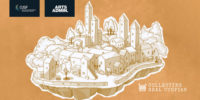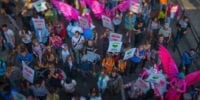Ancient, fresh visions of land
This is the third blog in the ‘Collecting Real Utopias’ series, which aims to collect, connect, and celebrate arts-based real utopian projects from around the world. It is rooted in Malaika’s research, which explores the overlaps between democracy, environmental justice, and participatory arts. To learn more about what is meant by ‘real utopias’ and the overall ambitions for this series, please have a look at Malaika’s first blog. This article also appeared on the Arts Admin website.
BLOG by MALAIKA CUNNINGHAM
We cannot talk about environmental justice or democracy without talking about land. From the requirement of land ownership in early voting systems, to massive food and housing inequalities today, questions about how we build a just and sustainable future come back to questions of how we organise, care for, and own land. Many of the blogs in this series will look at this subject from different angles in terms of food production, energy, and restorative practices. In this blog, I’ll be highlighting a couple arts projects which are challenging deep-rooted assumptions about who has access to land, and who is entitled to design and define it.
I would like to begin this month’s blog by acknowledging that most of the artists and producers leading the projects I’ll be discussing in this blog are Black. They are writing, organising, and creating work in relation to racial land justice, with their own lived experiences of racism and injustice. I am a white Canadian/British woman and do not have these experiences. The purpose of this blog is to celebrate and promote their work, and hopefully connect this work to others working in similar veins around the world. I will always reference those who I mention and encourage any reader interested in learning more about the projects and ideas discussed in this blog to explore these sources.
I have spent my 30 years quite neatly split between Nova Scotia, London, and Yorkshire. These three places have radically different landscapes. I remember that when I first moved to London, aged 14, I would boldly (and wrongly) complain that there wasn’t even one patch of untrampled grass in the whole city. I missed the vast and wild feeling of Nova Scotia. But in the overtly cultivated landscapes of the UK there is also a different kind of access. I now live in Sheffield, down the road from the site of the first mass trespass on Kinder Scout in 1932. A protest led by the workers of Sheffield, Manchester, and the surrounding mill towns marking a big moment in the ‘right to roam’ movement, and campaign for national parks and public footpaths. In the UK there is a culture of going out into the countryside and a sense that all the major hills, lakes, rivers, and coastlands of the UK are there to explored, for free, via this incredible network of footpaths. With all its wild beauty, in Nova Scotia this kind of access is hard. This is especially true on the ocean front, where vast swathes of beaches and islands have been bought up by millionaires who spend a couple weeks of summer there, but keep their fences and No Trespassing signs up all year round.
The incredible invitation to roam freely and explore the countryside of the UK is not equally extended to all. Access to this land, although technically open and public, is actually limited to those with the cultural, social, historical, and financial means to access it. This has been thrown into a particularly blinding light in this past year through multiple lockdowns. Racial and class-based inequalities of access to rural and green spaces are mirrored in poor quality housing and levels of air pollution. And these inequalities all come back to land justice—who owns it, who designs it, and who has the space and permission to breathe in it. This is generally acknowledged within a global context (i.e. the Global South facing the worst effects of a climate crisis largely caused by the Global North)—but it is also true on a national level. This is typified in Newham, home of London City Airport and some of the worst air quality in the country. The airport is predominately used by wealthy white businesspeople (with an average salary of roughly £114k a year). Those living around the airport are not these passengers, they are predominately Black and Asian, with 40% living on less than £20k a year.
This is not only about who has access to green spaces or who is able to own land, it is also about who is entitled to design the future of our land: both our built and green spaces. Inspiring work has been going on in Birmingham in relation to this. The MAIA Group curate and produce a multitude of events, programmes, and now two physical spaces which explore the role of community-rooted artists in designing and creating infrastructure and transformative social change. Their Creative Director, Amahra Spence, also set up the Black Land & Spatial Justice Fund, ‘developed to redistribute resources, including finance and knowledge, engaging in decolonial frameworks and collective organising to redefine our relationships to land and space.’ The MAIA Group’s events have been one of the key places I have begun to learn about land justice, and really begun to examine the ramifications of our colonial, hierarchical and extractive relationship with land. Simply put, if you are interested in land justice, you should definitely check out the MAIA Group.
Jennifer Farmer and Zoe Palmer, and their piece, the dream(ing) field lab is also a key project I want to discuss in relation to land justice. This work brings together a group of women and femmes of African heritage to gather in a ‘rural idyll’—to embark on collective dreaming, ‘to sit in the space of imagination’ and envision the world they want to live in. This project draws on Jennifer and Zoe’s experience as ecologists and herbalists, as well as their work as artistic facilitators, playwrights, and directors—blending these two fields of expertise to create a simultaneously land-focussed and artistic space. The symbiotic relationship between ritual, artistic practice, and land is complex and ancient (which cannot be given justice in this short blog). However, I will be exploring it in a bit more detail in my next blog. The dream(ing) field lab creates time and space for care, nourishment, and playfulness. No utopia is an island, and this work emerges from, and contributes to, African cosmologies, ecowomanism, and afrofuturism (also see Octavia’s Brood).
Globally Black women and femmes face some of the worst impacts of climate change and are simultaneously one of the least represented in the conversation about how we can re-imagine the system perpetuating these injustices. In my conversation with Zoe and Jennifer about the dream(ing) field lab, we spoke of who is entitled to own, access, and design the world we live in. A question we returned to a couple times in our chat was: “At what point do we deem ourselves worthy enough to hold visions of the world?” This project seeks to support, nurture, and celebrate its participants so that they are empowered not only to create visions, but also to dealing with the responses which come back from sending these visions out into the world. As well as spreading this spirit of care and joy back into their own communities.
There are layers of re-claiming here. It’s about Black women and femmes re-claiming relationships with land, as well as the right to design its future. The dream(ing) field lab is about taking up space, unfiltered and full; allowing the time and space, as well as the care and joy needed for visioning alternative worlds. As one participant put it: “I feel the remembrance and call of the land to accept, release and bask in the abundance that exists around.” And, crucially, there are the ripples circling out beyond this work. As another participant said: “I wish all Black femmes and women could experience this.”
I think that this project beautifully expresses a good deal of what real utopias are all about. My conversation with Zoe and Jennifer reminded me of this quote from Erik Olin Wright (the sociologist who coined the term ‘real utopias’—see blog 1 for more details):
“The idea of real utopias embraces the tension between dreams and practice. It is grounded in the belief that what is pragmatically possible is not fixed independently of our imaginations, but is itself shaped by our visions. Self-fulfilling prophecies are powerful forces in history, and while it may be naively optimistic to say ‘where there is a will there is a way’, it is certainly true that without a ‘will’ many ‘ways’ become impossible.” (Erik Olin Wright, 2010)
We need multiple ‘ways’ to create an environmentally and socially just future—without that pluralism, we risk creating new oppressions, and we miss beautiful and useful visions. With this in mind, the work of challenging who owns and accesses land, and, crucially, who is entitled to create visions of its future is central. This returns us to the themes of last month’s blog, and—of course—democracy. There are parallels between the work of Paulo Freire and Augusto Boal and the dream(ing) field lab. Freire asks us to ‘re-name the world’ to overcome our oppressions. He argues that ‘…we must perceive the reality of oppression not as a closed world from which there is no exit, but a limiting situation which we can transform’. Boal took on this challenge within his Theatre of the Oppressed. I believe Jennifer and Zoe are also answering this challenge with the dream(ing) field lab, by asking their collaborators to ‘sit in the space of imagination, and to conjure new worlds’. This is also a challenge I aim to take on in my own artistic practice, with our piece The People’s Palace of Possibility—which I will explore in more detail in a future blog. I mention it here as working on that project has been another spark for my interest in land justice and Zoe and Jennifer’s work.
All of this fundamentally comes back to the role that the arts play within this quest for real utopias—and the reason this blog (and my role) is hosted with Artsadmin. There is a great deal to be said on the role of participatory arts within democracy and environmental justice. But I want to highlight in this month’s blog is the crucial role of imagination and ‘conjuring’ new worlds into existence. The fictional, magical, playful, metaphorical, and strange spaces of participatory arts invite us to challenge how the world is and how it can be. These glimpses into new worlds become little kernels which we carry around with us – a tiny, real utopian kernel of an idea or feeling that we can change the world, and that we have seen something like what we want it to be. And those kernels are so, so important, they grow into realities – so without them, how can our utopias ever become real?
. . .
I want to thank Zoe and Jennifer for their time: talking me through their inspiring work, as well as their edits to this blog. I again want to point readers to look directly at their work, and the work of the MAIA Group. I also want to give a shout-out to Solidaritree and Alice + Abby, who are also making some great work around re-imagining land ownership systems in the UK—more specifically, they’ve been designing a game called the Isthmus Project.



